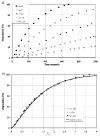A mathematical model of evolving mechanical properties of intraluminal thrombus
- PMID: 20164633
- PMCID: PMC2904399
- DOI: 10.3233/BIR-2009-0556
A mathematical model of evolving mechanical properties of intraluminal thrombus
Abstract
Quantifying mechanical properties of blood clots is fundamental to understanding many aspects of cardiovascular disease and its treatment. Nevertheless, there has been little attention to quantifying the evolving composition, structure and properties when a clot transforms from an initial fibrin-based mesh to a predominantly collagenous mass. Although more data are needed to formulate a complete mathematical model of the evolution of clot properties, we propose a general constrained mixture model based on diverse data available from in vitro tests on fibrinogenesis, the stiffness of fibrin gels, and fibrinolysis as well as histological and mechanical data from clots retrieved from patients at surgery or autopsy. In particular, albeit resulting from complex kinetics involving many clotting factors, we show that the rapid (minutes) in vitro production of fibrin from fibrinogen can be modeled well by an Avrami-type relation and similarly that the fast (tens of minutes) in vitro degradation of fibrin in response to different concentrations of plasmin can be captured via a single "master function" parameterized by appropriate half-times that can be inferred from laboratory or clinical data. Accounting simultaneously for the production and removal of fibrin as well as chemo-mechano-stimulated production of fibrillar collagens yields predictions of changing mass fractions and bulk mechanical properties that correspond well to experimentally available data. Constrained mixture models thus hold considerable promise for modeling the biomechanics of clot evolution and can guide the design and interpretation of needed experiments and stress analyses.
Figures








Similar articles
-
Recombinant fibrinogen reveals the differential roles of α- and γ-chain cross-linking and molecular heterogeneity in fibrin clot strain-stiffening.J Thromb Haemost. 2017 May;15(5):938-949. doi: 10.1111/jth.13650. Epub 2017 Mar 6. J Thromb Haemost. 2017. PMID: 28166607
-
The myeloperoxidase product, hypochlorous acid, reduces thrombus formation under flow and attenuates clot retraction and fibrinolysis in human blood.Free Radic Biol Med. 2019 Sep;141:426-437. doi: 10.1016/j.freeradbiomed.2019.07.003. Epub 2019 Jul 4. Free Radic Biol Med. 2019. PMID: 31279970
-
Physical determinants of fibrinolysis in single fibrin fibers.PLoS One. 2015 Feb 25;10(2):e0116350. doi: 10.1371/journal.pone.0116350. eCollection 2015. PLoS One. 2015. PMID: 25714359 Free PMC article.
-
Fibrin Formation, Structure and Properties.Subcell Biochem. 2017;82:405-456. doi: 10.1007/978-3-319-49674-0_13. Subcell Biochem. 2017. PMID: 28101869 Free PMC article. Review.
-
Clot properties and cardiovascular disease.Thromb Haemost. 2014 Nov;112(5):901-8. doi: 10.1160/TH14-02-0184. Epub 2014 Jun 5. Thromb Haemost. 2014. PMID: 24899357 Review.
Cited by
-
Biochemomechanics of intraluminal thrombus in abdominal aortic aneurysms.J Biomech Eng. 2013 Feb;135(2):021011. doi: 10.1115/1.4023437. J Biomech Eng. 2013. PMID: 23445056 Free PMC article. Review.
-
Impact of poroelasticity of intraluminal thrombus on wall stress of abdominal aortic aneurysms.Biomed Eng Online. 2012 Aug 29;11:62. doi: 10.1186/1475-925X-11-62. Biomed Eng Online. 2012. PMID: 22931215 Free PMC article.
-
Hemodynamic analysis of thrombosed intracranial aneurysms: a comparative correlation study.Neurosurg Rev. 2025 May 14;48(1):417. doi: 10.1007/s10143-025-03566-2. Neurosurg Rev. 2025. PMID: 40369300 Free PMC article.
-
Blood flow and coherent vortices in the normal and aneurysmatic aortas: a fluid dynamical approach to intra-luminal thrombus formation.J R Soc Interface. 2011 Oct 7;8(63):1449-61. doi: 10.1098/rsif.2011.0041. Epub 2011 Apr 6. J R Soc Interface. 2011. PMID: 21471188 Free PMC article.
-
Reactive Constrained Mixtures for Modeling the Solid Matrix of Biological Tissues.J Elast. 2017 Dec;129(1-2):69-105. doi: 10.1007/s10659-017-9630-9. Epub 2017 Mar 1. J Elast. 2017. PMID: 38523894 Free PMC article.
References
-
- Adolph R, Vorp DA, Steed DL, Webster MW, Kameneva MV, Watkins SC. Cellular content and permeability of intraluminal thrombus in abdominal aortic aneurysm. J Vasc Surg. 1997;25:916–926. - PubMed
-
- Alberts B, Johnson A, Lewis J, Raff M, Roberts K, Walter P. Molecular biology of the cell. New York: Garland Science; 2002.
-
- Anand M, Rajagopal K, Rajagopal KR. A model for the formation, growth, and lysis of clots in quiescent plasma. A comparison between the effects of antithrombin III deficiency and protein C deficiency. J Theor Biol. 2008;253:725–38. - PubMed
-
- Baek S, Rajagopal KR, Humphrey JD. A theoretical model of enlarging intracranial fusiform aneurysms. J Biomech Eng. 2006 Feb;128:142–149. - PubMed
Publication types
MeSH terms
Substances
Grants and funding
LinkOut - more resources
Full Text Sources
Other Literature Sources
Medical

